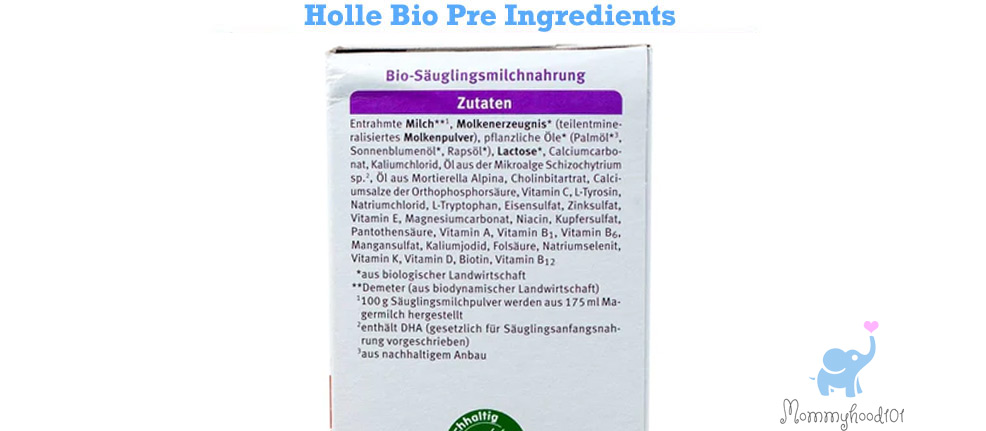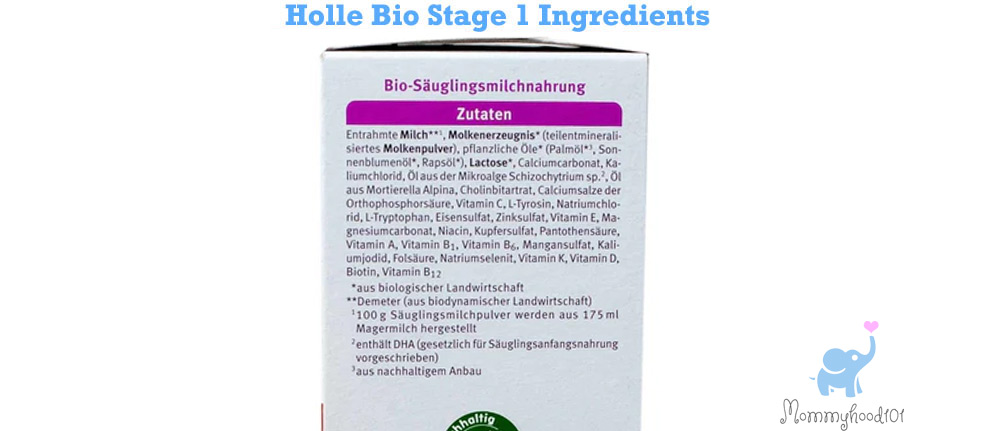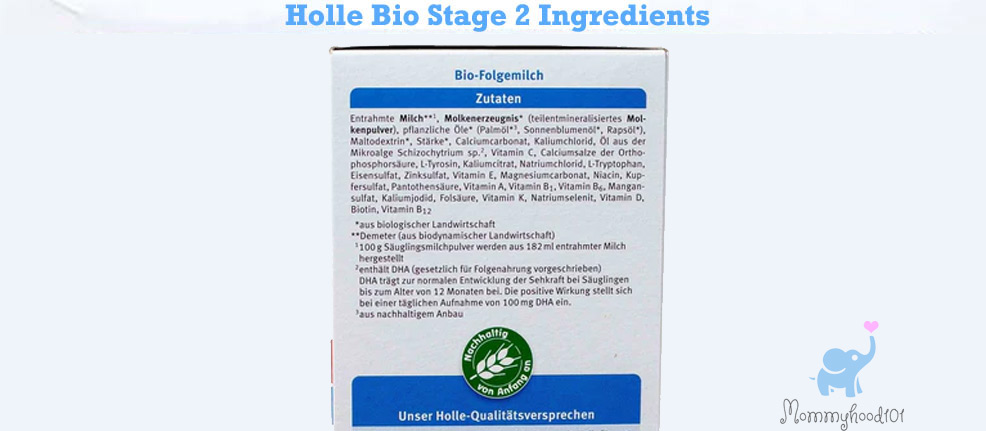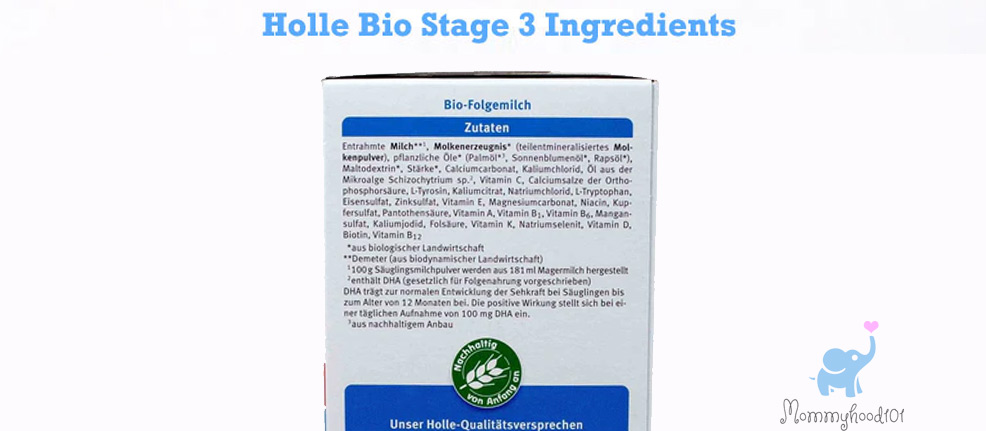Holle-y cow! Could this be the best baby formula for your little one? Let's find out.

Mommyhood101 independently tests and curates baby gear to help you make informed decisions. If you buy products through links on our site, we may earn a commission.
We did a hands-on test of the Holle Bio formulas and then consulted with a developmental nutritionist and international food sustainability expert to get their opinions.
Our conclusions were based on tests with three infants, opinions from parents currently feeding their babies (exclusively or as a supplement) with Holle Bio, and the ingredients and nutritional content relative to United States (FDA and USDA) recommendations.
Spoiler alert, we were very happy with the results of our testing and proud to keep Holle as a high-ranking option in our list of the best organic baby formulas!
Holle Pre is one of the only whole milk baby formulas on the market, along with the popular Kendamil organic formula (see our review here)., and we think it's an ideal baby formula for newborns. Remember to always ask your child's pediatrician before changing their formula.
-
- Holle Comparison Table
- Take-Home Message
- Some Translations to Know
- Holle Farming Practices
- Organic Farming
- Biodynamic Farming
- Sustainable Farming
- Holle Ingredients
- Holle Pre Ingredients
- Holle Stage 1 Ingredients
- Holle Stage 2 Ingredients
- Holle Stage 3 Ingredients
- Holle Stages: Ingredient Differences
- Holle Nutritional Analysis
- USDA Formula Recommendations
- Holle Bio Pre Nutrition
- Holle Bio Stage 1 Nutrition
- Holle Bio Stage 2 Nutrition
- Holle Bio Stage 3 Nutrition
- Holle Testing in Infants
- Conclusions
- Where to Buy Holle Formulas
- References Cited
| Holle Bio PRE (0-6 mo) | |
| Holle Bio Stage 1 (0-6 mo) | |
| Holle Bio Stage 2 (6+ mo) | |
| Holle Bio Stage 3 (10+ mo) | |
| Holle Bio Stage 4 (12+ mo) |
Holle Formulas: Take-home Message
Most people don't want to read this entire article to see what we found. So here is the summary of what we loved, and what we didn't.
✔️ High-quality organic formulation.
✔️ Demeter Biodynamic farming.
✔️ Nutrition near FDA & USDA guidelines.
✔️ First ingredient is whole or skim milk.
✔️ Nothing artificial.
✔️ Omega-3 and Omega-6 (LA, ALA, ARA, DHA).
✔️ No sucrose or corn syrups.
✔️ Gluten & soy free.
✔️ High infant acceptance, great taste!
✔️ No gas, indigestion, or constipation.
❌ Maltodextrin & starch (Stages 2-3).
❌ Palm Oil as a fat source.
Holle Formulas: Some Translations
Since the Holle packaging is in German, here are a few important translations.
Bio: This means Organic in German, and the EU and Germany take Organic standards very seriously. More on that later.
Anfangsmilch: This means Starting Milk in German, meaning that it is intended to be used from birth onward (usually up to 6 months).
Folgemilch: This means Follow-On Milk in German, meaning that it is intended to be used from 6 months onward (nach dem 6 monat).
Holle Formulas: Best Practices?
Holle is not only one of the biggest and most popular European baby formula companies, it is also one of the originals. Founded in 1933 in Switzerland, Holle has been around for nearly 100 years and has consistently grown its reputation for producing high-quality, organic, biodynamic baby formulas using sustainable farming and manufacturing processes.
Holle makes several strong claims about their farming and manufacturing processes that we wanted to explore.
To do so, we gathered insights from an expert food sustainability consultant based in Lausanne, Switzerland. Some of the questions we asked are included below.
Overall, we found that by following the strict Organic and Biodynamic regulations in Germany and the EU, Holle follows responsible and sustainable farming practices, and produces a very high-quality product.
What are the EU's organic regulations?
The European Union (EU) has a strict system of organic controls that are enforced through an annual inspection process. These inspections result in an annual certificate being issued for conforming products.
While Holle is based in Switzerland, they manufacture their products in Germany, which is the largest organic food market in the EU. Here are the specific organic regulatory criteria used by Germany:
- No protecting plants by using synthetic chemicals such as herbicides or pesticides.
- No use of soluble mineral fertilizers.
- No application of chemical growth regulators.
- Feeding animals with farm-grown feed, not purchased feed, when possible.
- No use of antibiotics other than to treat an infection.

Overall, to use the EU-certified organic label (above), products must meet a stringent 98% organic content (by weight). By comparison, the United States USDA organic certification process has a 95% minimum.
What is a Biodynamic (Demeter) farm?
Biodynamic farming is extremely popular in Europe, especially Germany, and follows a long (since 1924!) tradition of sustainability. Biodynamic wines, for example, are highly sought after for their purity and taste.
Biodynamic farming refers to practices that are environmentally adapted, following very similar criteria to organic farming. However, in addition to following organic farming practices, Biodynamic farming also includes several holistic and ethical (and some esoteric) practices.
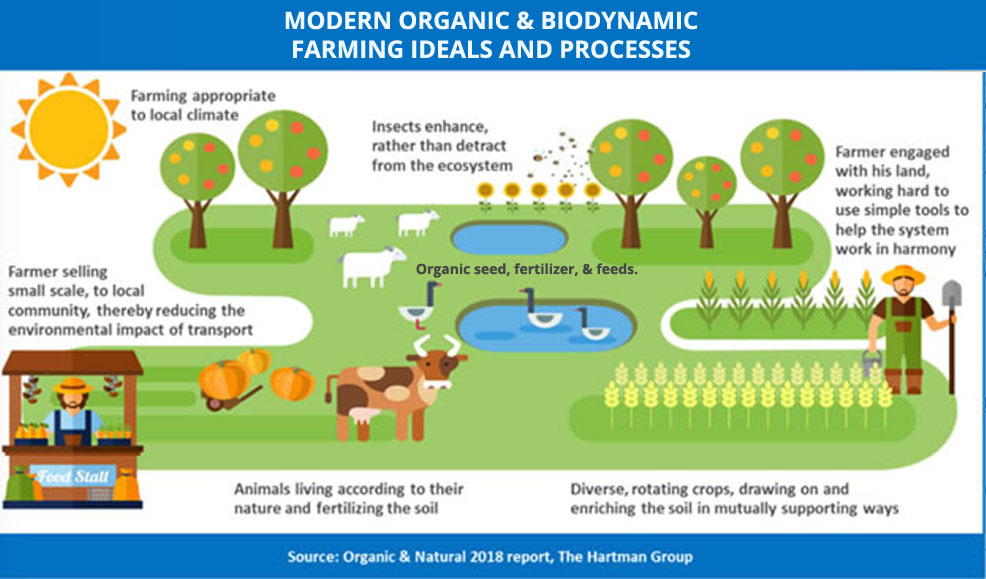
For example, traditional biodynamic farming included mystical or spiritual approaches, such as harnessing cosmic forces in the soil or using astrology to guide the planting calendar. The modern Demeter certification system for Biodynamic farming practices uses more modern requirements that are very similar to those used for organic farming.
Not surprisingly, studies show there are no significant differences between organic farming and biodynamic farming practices, in terms of the quality or quantity of products. However, biodynamic farming does carry substantial benefits for sustainability, when done correctly.
Are the Holle farming and manufacturing processes really sustainable?
Yes, Biodynamic farming practices emphasize sustainability by using a stringent closed-cycle agriculture process.
In other words, from seeds, manure, and compost, all the way to animal feeding and care, is sourced from within the farm itself. This means much greater control over farming practices, a much lower risk of external influence, and much less waste.
For example, the seeds used to grow the organic plants that feed the cows are harvested from the farm's own crops, as opposed to purchasing seeds from outside sources that might be modified. Similarly, the manure used to fertilize the plants is gathered from the cows that are fed the organic crops, as opposed to purchasing manure or compost from outside sources.
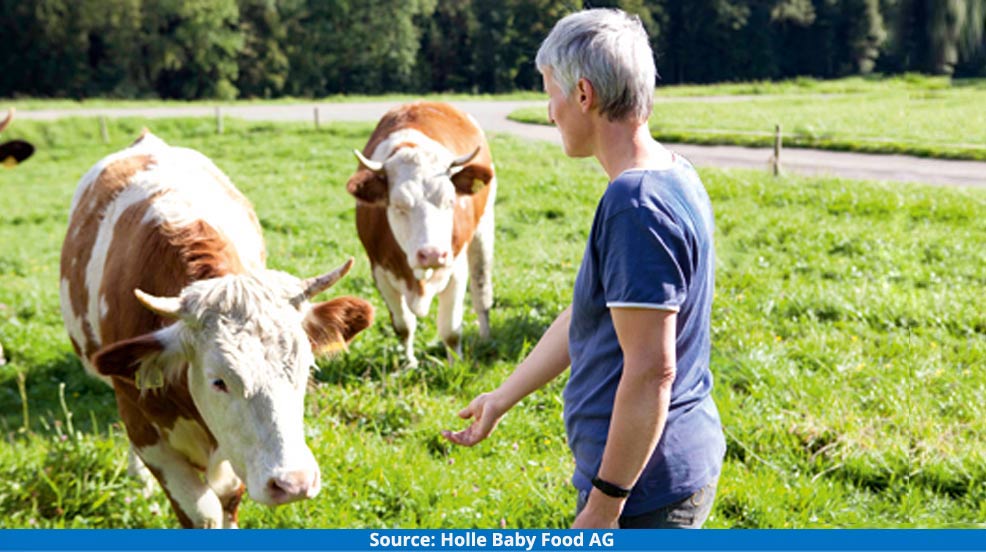
These controls are very important for sustainability, including conserving soil (by regenerating its biomass with local manure), protecting species diversity (by not using pesticides), conserving water (by not contaminating water sources with chemicals), and promoting animal welfare. An example of appropriate animal husbandry at Holle is their cows graze on open fields and pastures, and they do not subject their cows to painful dehorning.

Of course, dairy farming, whether cows, goats (check out our Jovie goat milk formula review!), or any other animal, has its set of drawbacks. These include high methane emissions and livestock waste. In a truly closed-cycle farm, livestock waste should hold much less of an impact, and Biodynamic farming is a great step towards sustainable dairy farming.
Holle Formula Ingredients
Here we consider the ingredients in the cow milk version of Holle Bio.
Note that Holle changed their ingredients as of mid-2023. Some shops might be shipping the old formulation with fish oil, whereas other shops may be shipping the new formulation that uses microalgae and M. Alpina oil as DHA and ARA sources (respectively). We reached out to Holle about whether they extract DHA from these sources with Hexane, but they have not yet responded.
The use of Organic, Biodynamic, and sustainable farming practices will provide some relatively intangible benefits for the quality of Holle infant formulas. These benefits do not appear on an ingredient label and include minimal trace pesticides, herbicides, antibiotics, or heavy metals.
Here are the ingredients in each of the Holle Bio baby formulas:
Holle Bio Pre Ingredients (translated): Skimmed milk, whey product (partly demineralized whey powder), vegetable oils (palm oil, sunflower oil, rapeseed oil), lactose, calcium carbonate, potassium chloride, oil from the Microalgae Schizochytrium Sp., oil from Mortierella Alpina, choline bitartrate, calcium salts of orthophosphoric acid, Vitamin C, L-Tyrosine, sodium chloride, L-Tryptophan, ferrous sulfate, zinc sulfate, vitamin E, magnesium carbonate, niacin, copper sulfate, pantothenic acid, vitamin A, vitamin B1, vitamin B6, manganese sulfate, potassium iodide, folic acid, sodium selenite, vitamin K, vitamin D, biotin, vitamin B12.
Holle Stage 1 Ingredients (translated): Skimmed milk, whey product (partly demineralized whey powder), vegetable oils (palm oil, sunflower oil, rapeseed oil), lactose, calcium carbonate, potassium chloride, oil from the Microalgae Schizochytrium Sp., oil from Mortierella Alpina, choline bitartrate, calcium salts of orthophosphoric acid, Vitamin C, L-Tyrosine, sodium chloride, L-Tryptophan, ferrous sulfate, zinc sulfate, vitamin E, magnesium carbonate, niacin, copper sulfate, pantothenic acid, vitamin A, vitamin B1, vitamin B6, manganese sulfate, potassium iodide, folic acid, sodium selenite, vitamin K, vitamin D, biotin, vitamin B12.
Holle Stage 2 Ingredients (translated): Skimmed milk, whey product (partially demineralised whey powder), vegetable oils (palm oil, sunflower oil, rapeseed oil), maltodextrin, starch, calcium carbonate, potassium chloride, oil from the Microalgae Schizochytrium Sp., Vitamin C, calcium salts of orthophosphoric acid, L-Tyrosine, potassium citrate, sodium chloride, L-Tryptophan, iron sulfate, zinc sulfate, vitamin E, magnesium carbonate, niacin, copper sulfate, pantothenic acid, Vitamin A, Vitamin B1, Vitamin B6, manganese sulfate, potassium iodide, folic acid, Vitamin K, sodium selenite, Vitamin D, biotin, Vitamin B12.
Holle Stage 3 Ingredients (translated): Skimmed milk, whey product (partially demineralised whey powder), vegetable oils (palm oil, sunflower oil, rapsol), maltodextrin, starch, calcium carbonate, potassium chloride, oil from the Microalgae Schizochytrium Sp., Vitamin C, calcium salts of orthophosphoric acid, L-Tyrosine, potassium citrate, sodium chloride , L-Tryptophan, iron sulfate, zinc sulfate, vitamin E, magnesium carbonate, niacin, copper sulfate, pantothenic acid, Vitamin A, Vitamin B1, Vitamin B6, manganese sulfate, potassium iodide, folic acid, Vitamin K, sodium selenite, Vitamin D, biotin, Vitamin B12.
Here are some ingredients that are not in any of the stages of Holle Bio: corn syrup, corn syrup solids, artificial colors, flavors, or preservatives, sucrose, soy, genetically modified organisms (GMOs), carrageenan, or high fructose corn syrup.
Some ingredients we didn't appreciate: Maltodextrin as a thickening carbohydrate is present in Stages 1-4 (but not Pre), and palm oil is included in the Pre and all stages.
Holle Stages: Ingredient Differences
1. Holle Bio Pre versus Stage 1: There are no differences between the ingredients in Holle Bio Pre and Stage 1. Of course, this does not mean they have identical nutritional composition; indeed, formulas often vary in their proportions of ingredients to modify the relative fat, sugar, and protein content.
2. Holle Bio Stage 1 versus Stage 2: There are three main differences between Holle Bio Stage 1 and 2. First, Stage 2 (and 3) adds maltodextrin and organic starch (1g/100mL), which are carbohydrates and thickening agents. Second, Stage 2 no longer includes lactose, a preferred carbohydrate source in baby formula, and also omits oil from Mortierella Alpina (a source of ARA). Stage 2 is intended for use from 6 months onward.
3. Holle Stage 2 versus Stage 3: There are no differences between the ingredients in Holle Bio Stages 1 and 2. Of course, this does not mean they have identical nutritional composition; indeed, formulas often vary in their proportions of ingredients to modify the relative fat, sugar, and protein content.
Holle Formula Nutritional Analysis
To gather insights into whether Holle Bio meets US nutritional recommendations by the US Department of Agriculture (USDA) and the American Academy of Pediatrics, we gathered insights from a dietician nutritionist with expertise in infant feeding. In addition to offering us guidance, he also directed us to the USDA's published recommendations (see References).
Note that the US FDA also publishes minimum infant formula nutritional requirements (see references), but all of the infant formulas we reviewed met these published standards, and they are only relevant for 0-6 months. Because the Holle formulas appear to meet the FDA minimum requirements (according to our review), we compared them to the more general USDA daily intake recommendations.
The USDA does not publish recommended daily allowances (RDAs) for infants between 0-6 months. Instead, they publish information about Adequate Intakes (AI), which are used when there is not enough evidence to make a formal RDA. The AI is set at a level assumed to provide nutritional adequacy.
Here are the USDA's AIs (per day) for infants aged 0-6 months, and 6-12 months. Units are grams (g), milligrams (mg), and micrograms (μg).
USDA Nutritional Recommendations:
| Carbohydrates | 0-6mo: 60g | 6-12mo: 95g |
| Proteins | 0-6mo: 9.1g | 6-12mo: 11g |
| Fats | 0-6mo: 31g | 6-12mo: 30g |
| Omega-3 | 0-6mo: 0.5g | 6-12mo: 0.5g |
| Omega-6 | 0-6mo: 4.4g | 6-12mo: 4.6g |
| Vitamin A | 0-6mo: 400μg | 6-12mo: 500μg |
| Vitamin B1 | 0-6mo: 0.2mg | 6-12mo: 0.3mg |
| Vitamin B2 | 0-6mo: 0.3mg | 6-12mo: 0.4mg |
| Vitamin B6 | 0-6mo: 0.1mg | 6-12mo: 0.3mg |
| Vitamin B12 | 0-6mo: 0.4μg | 6-12mo: 0.5μg |
| Vitamin C | 0-6mo: 40mg | 6-12mo: 50mg |
| Vitamin D | 0-6mo: 5μg | 6-12mo: 5μg |
| Vitamin E | 0-6mo: 4mg | 6-12mo: 5mg |
| Vitamin K | 0-6mo: 2μg | 6-12mo: 2.5μg |
| Folate | 0-6mo: 65μg | 6-12mo: 80μg |
| Niacin | 0-6mo: 2mg | 6-12mo: 4mg |
| Calcium | 0-6mo: 210mg | 6-12mo: 270mg |
| Iron | 0-6mo: 0.27mg | 6-12mo: 11mg |
Given that the Pre and Stage 1 formulas are intended for use from birth to 6 months, we evaluated their nutritional content against the USDA 0-6 month recommendations. For the Stage 2 and 3 versions, we evaluated against the USDA 6-12 month recommendations.
Because the USDA recommendations are for daily intake, we considered the daily intake recommended by Holle in their "Meal Tables." The Pre suggests an average of about 100 grams of formula per day for the first 6 months; of course, this is lower (about 80 grams) for the first month, then increases with age to over 100g/day.
To derive an estimate of how many nutrients a baby would receive each day, we used the average recommended serving for the first 6 months (about 100 grams of formula per day). This will overestimate nutrients in the early months, and underestimate them in later months. As you will see from our analysis, this isn't causing much concern.
Does Holle Bio Pre Meet USDA Nutritional Recommendations?
In general, yes, very similar to US-made baby formulas. Here is a table comparing the USDA recommendation for 0-6 months to what the Holle Bio Pre provides (in 100g of formula):
| Carbohydrates | USDA: 60g | Bio Pre: 58.9g |
| Proteins | USDA: 9.1g | Bio Pre: 10.1g |
| Fats | USDA: 31g | Bio Pre: 25.1g |
| Omega-3 | USDA: 0.5g | Bio Pre: 0.49g |
| Omega-6 | USDA: 4.4g | Bio Pre: 3.7g |
| Vitamin A | USDA: 400μg | Bio Pre: 471μg |
| Vitamin B1 | USDA: 0.2mg | Bio Pre: 0.46mg |
| Vitamin B2 | USDA: 0.3mg | Bio Pre: 1.4mg |
| Vitamin B6 | USDA: 0.1mg | Bio Pre: 0.43mg |
| Vitamin B12 | USDA: 0.4μg | Bio Pre: 1.6μg |
| Vitamin C | USDA: 40mg | Bio Pre: 104mg |
| Vitamin D | USDA: 5μg | Bio Pre: 10μg |
| Vitamin E | USDA: 4mg | Bio Pre: 11mg |
| Vitamin K | USDA: 2μg | Bio Pre: 47μg |
| Folate | USDA: 65μg | Bio Pre: 221μg |
| Niacin | USDA: 2mg | Bio Pre: 3.5mg |
| Calcium | USDA: 210mg | Bio Pre: 423mg |
| Iron | USDA: 0.27mg | Bio Pre: 4mg |
Notice how close all of those numbers are to each other. We compared the Holle Bio Pre nutritional profile with the most popular Similac and Enfamil formulas, and it's all extremely similar.
In other words, Holle Bio Pre provides an overall nutritional profile that is not only in line with USDA recommendations but also very similar to the major American baby formula brands.
Does Holle Bio Stage 1 Meet USDA Nutritional Recommendations?
In general, yes. Here is a table comparing the USDA recommendation for 0-6 months to what the Holle Bio Stage 1 provides (in 100g of formula):
| Carbohydrates | USDA: 60g | Stage 1: 58.1g |
| Proteins | USDA: 9.1g | Stage 1: 10.4g |
| Fats | USDA: 31g | Stage 1: 26g |
| Omega-3 | USDA: 0.5g | Stage 1: 0.54g |
| Omega-6 | USDA: 4.4g | Stage 1: 4.6g |
| Vitamin A | USDA: 400μg | Stage 1: 446μg |
| Vitamin B1 | USDA: 0.2mg | Stage 1: 0.49mg |
| Vitamin B2 | USDA: 0.3mg | Stage 1: 1.4mg |
| Vitamin B6 | USDA: 0.1mg | Stage 1: 0.43mg |
| Vitamin B12 | USDA: 0.4μg | Stage 1: 1.5μg |
| Vitamin C | USDA: 40mg | Stage 1 105mg |
| Vitamin D | USDA: 5μg | Stage 1: 10μg |
| Vitamin E | USDA: 4mg | Stage 1: 13mg |
| Vitamin K | USDA: 2μg | Stage 1: 48μg |
| Folate | USDA: 65μg | Stage 1: 229μg |
| Niacin | USDA: 2mg | Stage 1: 3.4mg |
| Calcium | USDA: 210mg | Stage 1: 423mg |
| Iron | USDA: 0.27mg | Stage 1: 4.1mg |
Similar to Bio Pre, Stage 1 has a very similar nutritional profile to the USDA recommendations for infant formulas (0-6 months). For both the Pre and Stage 1, the average fat content is slightly lower than the USDA recommendation; but if you assume daily feedings reach about 120g/day of the Holle formula, then you will be exactly on the recommendation for fat intake (31g/day).
Does Holle Bio Stage 2 Meet USDA Nutritional Recommendations?
In general, yes. Here is a table comparing the USDA recommendation for 6-12 months to what the Holle Bio Stage 2 provides (in 100g of formula):
| Carbohydrates | USDA: 95g | Stage 2: 60.8g |
| Proteins | USDA: 11g | Stage 2: 10.1g |
| Fats | USDA: 30g | Stage 2: 23.8g |
| Omega-3 | USDA: 0.5g | Stage 2: 0.51g |
| Omega-6 | USDA: 4.6g | Stage 2: 4.2g |
| Vitamin A | USDA: 500μg | Stage 2: 455μg |
| Vitamin B1 | USDA: 0.3mg | Stage 2: 0.45mg |
| Vitamin B2 | USDA: 0.4mg | Stage 2: 1.1mg |
| Vitamin B6 | USDA: 0.3mg | Stage 2: 0.36mg |
| Vitamin B12 | USDA: 0.5μg | Stage 2: 1.4μg |
| Vitamin C | USDA: 50mg | Stage 2: 105mg |
| Vitamin D | USDA: 5μg | Stage 2: 12μg |
| Vitamin E | USDA: 5mg | Stage 2: 12mg |
| Vitamin K | USDA: 2.5μg | Stage 2: 52μg |
| Folate | USDA: 80μg | Stage 2: 237μg |
| Niacin | USDA: 4mg | Stage 2: 3.5mg |
| Calcium | USDA: 270mg | Stage 2: 470mg |
| Iron | USDA: 11mg | Stage 2: 5.9mg |
In terms of macronutrients (proteins, fats, carbohydrates), you'll notice that your growing baby will need more than the 100g/day serving. The micronutrient content, however, is very much in line with USDA recommendations.
Of course, it is important to realize that once a baby reaches 6+ months, most parents begin to introduce solid foods in addition to formula or breastfeeding. These usually first include rice and/or oatmeal cereals, and then progress to fruit and vegetable purees. These will complement the nutrition found solely in the formula, including additional iron.
Does Holle Bio Stage 3 Meet USDA Nutritional Recommendations?
In general, yes. Here is a table comparing the USDA recommendation for 6-12 months to what the Holle Bio Stage 3 provides (in 100g of formula):
| Carbohydrates | USDA: 95g | Stage 3: 55.7g |
| Proteins | USDA: 11g | Stage 3: 10.5g |
| Fats | USDA: 30g | Stage 3: 27.6g |
| Omega-3 | USDA: 0.5g | Stage 3: 0.52g |
| Omega-6 | USDA: 4.6g | Stage 3: 4.5g |
| Vitamin A | USDA: 500μg | Stage 3: 360μg |
| Vitamin B1 | USDA: 0.3mg | Stage 3: 0.73mg |
| Vitamin B2 | USDA: 0.4mg | Stage 3: 1.2mg |
| Vitamin B6 | USDA: 0.3mg | Stage 3: 0.56mg |
| Vitamin B12 | USDA: 0.5μg | Stage 3: 1.1μg |
| Vitamin C | USDA: 50mg | Stage 3: 68mg |
| Vitamin D | USDA: 5μg | Stage 3: 12μg |
| Vitamin E | USDA: 5mg | Stage 3: 10mg |
| Vitamin K | USDA: 2.5μg | Stage 3: 42μg |
| Folate | USDA: 80μg | Stage 3: 275μg |
| Niacin | USDA: 4mg | Stage 3: 3.7mg |
| Calcium | USDA: 270mg | Stage 3: 515mg |
| Iron | USDA: 11mg | Stage 3: 7.1mg |
In terms of macronutrients (proteins, fats, carbohydrates), you'll notice that your growing baby will need more than the 100g/day serving, especially in terms of carbohydrates. Like with the Stage 2 formula, Stage 3 is a little weak on iron, but at this point (Stage 3 is for 10+ months) you should definitely be introducing solid foods, including at least rice and/or oatmeal baby cereals.
A few things worth mentioning about the nutritional contents of Holle Bio formulas. You may not have noticed, but all stages of Holle formulas include both omega-3 and omega-6 fatty acids, including linoleic acid (LA), alpha-linolenic acid (ALA), and docosahexaenoic acid (DHA). Scientific evidence is showing how important these are for your baby's development, including central and peripheral nervous system development.
Second, some parents might be interested to learn that Holle formulas contain trace levels of fluoride. This is not added by the manufacturer, but appears in trace amounts (< 0.07mg per 100g, or < 0.01 per 100mL) due to the water used during manufacturing. This is equivalent to less than 0.10 mg of fluoride in a liter of prepared formula, which is much less than found in bottled water (about 0.4mg per liter), and way less than found in fluoridated tap water (about 5mg per liter).
Holle Formula Testing in Infants
We tested Pre, Stage 1, and Stage 2 varieties in three infants, one aged 3 months (Pre), one 5 months (Stage 1), and one 9 months (Stage 2).
Mixing and Taste-Testing
The first thing we noticed is that the Holle formulas were not clumpy or bubbly during or after mixing. They did a nice job blending easily with water, and any bubbles settled quickly.
We did try fortifying breastmilk with this formula (only if your doctor says so!), and it mixed very nicely.
Safety First: Never prepare powdered formula with anything but water. If you're interested in fortifying your breast milk with formula you must ask your doctor for guidance first, as this can be very dangerous for your baby.
The second thing we noticed was that the Holle formulas have a creamier texture and taste than most US formulas. Especially the Pre version, which uses whole milk, but also the Stage 1 formula had a really good texture.
Feeding with Holle
All three babies took the Holle formula without any difficulties. Two of the babies were previously formula-supplemented (with US brands), and one was exclusively breastfed. The first two took the Holle very easily, and the third had a bit of hesitation at first but seemed to accept it very nicely after a few minutes.
None of the babies developed any noticeable gas relative to their usual post-feeding burps or spit-up. The same goes for constipation and bowel movements, which the parents reported proceeded as usual after feeding twice with Holle. One of the parents switched to Holle entirely after testing it, which is a pretty good testament to its acceptance!
Conclusions
You won't be surprised to hear that we're really excited about Holle Bio and the amazing line of baby formulas they offer. While this review was only about their cow formula, they also make a very similar, and similarly excellent line of Holle Goat Milk formulas.
We were very impressed by Holle's use of sustainable dairy farming practices, its Demeter certification for Biodynamic farming, and its conformity with stringent EU and German organic product criteria.
The ingredients and nutritional profiles were high quality without any big compromises. We weren't totally impressed with the use of food starch as a thickener or carbohydrate, but that's really a very small gripe relative to what you see being put into US-made baby formulas. In our comparison of HiPP versus Holle formulas, we favor HiPP generally but also note how simple Holle is, and their superior ingredients sourcing and sustainability practices.
In our comparison of Lebenswert versus Holle formulas, we favor Lebenswert by a slim margin, but mostly because it doesn't use maltodextrin in Stage 1, and it's a bit less expensive than Holle.
In terms of mixing, taste, and acceptance, the Holle formula was excellent, and that opinion jives with what we've heard from hundreds of parents who use Holle, including neighbors, friends, and our loyal readers!
Expensive? Yes. All baby formula is expensive, and Holle and other European formula brands (also see our reviews of HiPP Combiotic formula, and our reviews of Lebenswert) are among the most expensive on the market. But we believe it's well worth the cost, especially if you value organic products, sustainable agriculture, and the quality and safety that come along with this brand.
Where to Buy Holle Formulas?
Over the past 10+ years of operating Mommyhood101, we have worked with several companies that import European baby formulas to the United States.
Most of the companies have come and gone, some were pushed out by new FDA labeling requirements for European formulas, and some couldn't maintain their supply chain logistics and tended to ship expired or poorly handled formulas.
One of the most reliable retailers of European baby formulas (including Holle, HiPP, Lebenswert, and Loulouka), with some of the best prices you can find, is Organic Life Start. Not only that, but they have free and super fast shipping, and they stock most formulas, ready for immediate shipping.
References Cited
German Organic Farming Regulations
Demeter Biodynamic Farming Certification
Consulting Dietician Nutritionist (Mr. John Anderson)
Consulting Food Sustainability Expert (Dr. Alexi Ernstoff)
United States FDA Infant Formula Nutrient Requirements
United States USDA Infant Nutritional Needs & Recommendations
Published Analysis of Nutritional Contents of European Baby Formulas
Disclaimer: To our knowledge, all ingredient and nutritional information contained in this article was accurate at the time of publication. We make no guarantees regarding the accuracy or timeliness of the information. Always read the packaging and instructions, and consult with your child's pediatrician before making nutritional and feeding decisions. Baby formulas manufactured and labeled for sale in Europe may or may not be approved for sale in the USA by the FDA or other regulatory bodies, so consumer discretion is advised.







